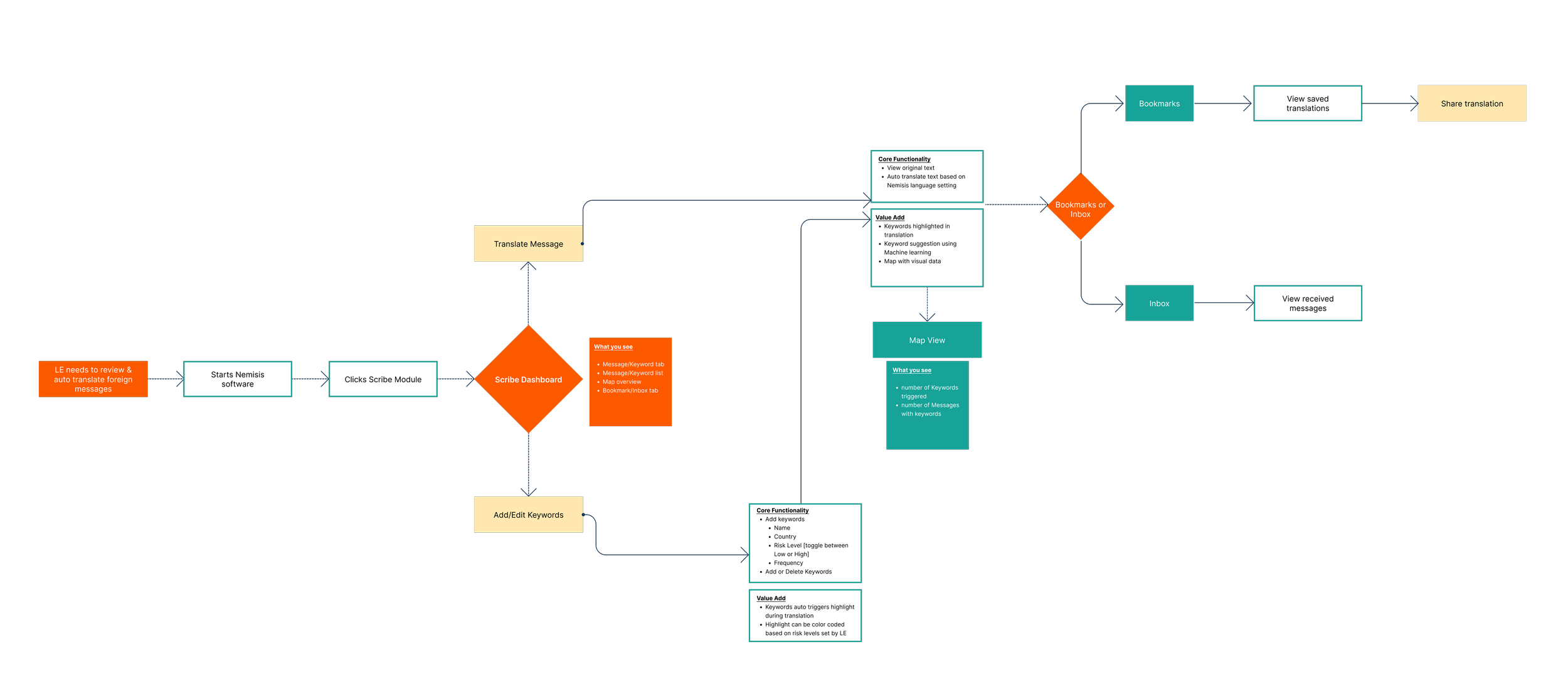Scribe
Scribe was a project developed during a TechSprint competition in collaboration with the Child Rescue Coalition (CRC), a non-profit organization dedicated to protecting children from sexual exploitation. CRC empowers law enforcement agencies worldwide by providing technology that helps identify, apprehend, and prosecute offenders.
During the sprint, our challenge was to design a digital tool that could support these life-saving efforts through innovative, ethical, and scalable technology.
Project Details
Year: July 2022
Skills: UX, UI, visual, and web design
Client: Child Rescue Coalition
The brief
CRC and CRC and law enforcement agencies face a significant barrier: the inability to translate suspicious text messages in real time, which delays investigations and the identification of potential offenders.
Our team proposed Scribe, an interactive translation hub that integrates seamlessly with existing law enforcement toolsets. Powered by machine learning, Scribe allows investigators to translate and analyze text instantly, helping them identify threats faster and more efficiently. enforcement agencies can’t translate suspicious text messages on-demand; thus, they can’t identify suspects for prosecution.
The impact
Our solution, Scribe, was recognized among the top five finalists out of more than thirty participating teams in the TechSprint competition.
Beyond recognition, the project underscored how thoughtful design and technology can work hand in hand to create tools that truly make a difference and helps protect vulnerable communities and supporting those working on the front lines of child safety.
A glimpse into my role…
As the UX and UI Designer, I worked alongside a team of four: two designers, one front-end developer, and one back-end developer, during a TechSprint hosted by Child Rescue Coalition + GeoComply.
My responsibilities included designing the user experience and interface, conducting user testing, and performing QA to ensure that our prototype was both functional and intuitive. Collaborating closely with the developers allowed me to align design decisions with technical feasibility and deliver a cohesive final solution.
Understanding the problem
This project focused on designing a tool to assist law enforcement agencies in translating suspicious text messages gathered from databases, group chats, web forums, and websites.
Because the Child Rescue Coalition (CRC) collaborates with agencies around the world, many investigators encounter a major challenge: they can’t always identify high-risk activity written in other languages. This language barrier creates a significant obstacle in detecting and prosecuting online predators.
Our goal was to design a tool that could integrate seamlessly into existing law enforcement systems, minimizing disruption and requiring little to no additional training. Given the sheer volume of information received every second, we needed an approach that could handle real-time translation at scale.
While machine learning offered the most powerful and scalable solution, the challenge lay in implementing it efficiently within the constraints of current law enforcement workflows.
Approaching this challenge through machine learning presented several constraints, the most pressing of which was figuring out how to design and deliver a working prototype within a tight two-week sprint.
How we solved the issue
Working tirelessly throughout the sprint, our team quickly realized that developing a fully functional solution for CRC would take more time than the two-week window allowed. Instead of rushing the process, we focused on ensuring that every decision we made aligned with the real needs of our users.
While our approach wasn’t the fastest, it was the most effective, providing a scalable, innovative translation tool capable of handling multiple languages and supporting law enforcement teams across the globe.
My approach began with understanding the pain points experienced by CRC and law enforcement agents during the translation process. Since time was a critical factor, the design needed to work at the same speed as investigations, providing instant access to translated information without disrupting daily workflows.
The goal was to create an interactive dashboard that allowed users to access real-time translation tools efficiently. After several rounds of brainstorming and iteration, it became clear that the design had to balance interactivity, clarity, and innovation through technology.
Some of the key features included:
Easy access to critical details such as date, recipient, detected language, translation, and risk level, helping users locate vital information quickly.
Level of risk indicator: Using machine learning, the system identifies potentially harmful or coded language. “Risk words” are automatically highlighted during translation, and the number of flagged words determines the overall risk score for each message.
Heat map visualization: A global map that highlights where high-risk activity is most concentrated, showing which languages and regions are most active, helping agents identify trends and simplify the prosecution process.
Cross-agency sharing: A secure feature that allows agents to share flagged cases with colleagues in other countries, strengthening global collaboration and reducing the risk of predators escaping prosecution.
This combination of functionality and innovation ensured that Scribe supported law enforcement with speed, precision, and usability, while remaining adaptable to the diverse needs of agencies worldwide.
My approach
Takeaways
-
Working for CRC and law enforcement agents meant designing blindfolded. Given the sensitivity of the information we had to work with, many things were censored for us. This meant that we had to work around many limitations when it came to understanding our user needs.
While we wanted to provide a fully functional prototype, we also wanted something visually captivating. Given the time to work on this project, UX was our main focus throughout the process. Although UI was not our main focus, we still delivered a product that aligns with our quality standards as industry professionals. -
For law enforcement agents, going through a vast amount of information daily can be excruciatingly tiring. Our product focused on maintaining a simple design and approach that would be intuitive while adding interactivity to users' workflows.



